
Soursop is the fruit of Annona muricata, a broadleaf, flowering, evergreen tree. It is native to the tropical regions of the Americas and the Caribbean and is widely propagated. It is in the same genus, Annona, as with cherimoya and custard apple and is in the Annonaceae family.

Cytisus scoparius, the common broom or Scotch broom, is a deciduous leguminous shrub native to western and central Europe. In Great Britain and Ireland, the standard name is broom; this name is also used for other members of the Genisteae tribe, such as French broom or Spanish broom; and the term common broom is sometimes used for clarification. In other English-speaking countries, the most common name is "Scotch broom" ; however, it is known as English broom in Australia.
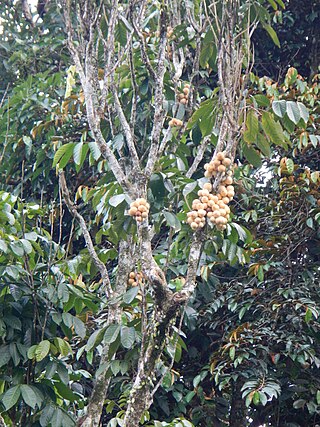
Lansium domesticum, commonly known as langsat or lanzones (,--) is a species of tree in the family Meliaceae with commercially cultivated edible fruits. The species is native to Southeast Asia, from peninsular Thailand and Malaysia to Indonesia and the Philippines.

Genista monspessulana, commonly known as French broom, Montpellier broom, or Cape broom (Australia), is a woody leguminous perennial shrub. The yellow-flowering bush is native to the Mediterranean region, and while it may still be commonly sold in some garden stores, it is considered an invasive plant in most places where it has been introduced. It is a noxious weed on the western coast of the US and in parts of Australia.

Consolida regalis, known as forking larkspur, rocket-larkspur, and field larkspur, is an annual herbaceous plant belonging to the genus Consolida of the buttercup family (Ranunculaceae).
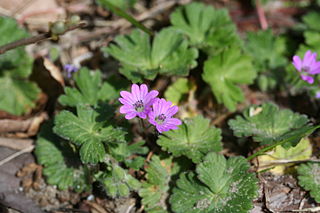
Geranium molle, the dove's-foot crane's-bill or dovesfoot geranium, is an annual herbaceous plant of the family Geraniaceae.
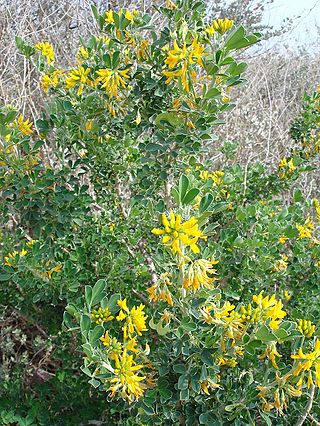
Medicago arborea is a flowering plant species in the pea and bean family Fabaceae. Common names include moon trefoil, shrub medick, alfalfa arborea, and tree medick. It is native to several Mediterranean Basin countries – Spain and the Balearic Islands, Italy including and Sardinia and Sicily, Greece including Crete and the East Aegean Islands, and Turkey. It primarily grows on rocky shores among shrubby vegetation. It forms a symbiotic relationship with the bacterium Sinorhizobium meliloti, which is capable of nitrogen fixation. It is the only member of the genus Medicago which is used as an ornamental. M. arborea is sometimes misidentified as Cytisus, which it resembles.

Cytisus striatus is a species of flowering plant in the legume family known by the common names hairy-fruited broom and Portuguese broom. This plant is native to the west of the Iberian Peninsula and northwestern Morocco.
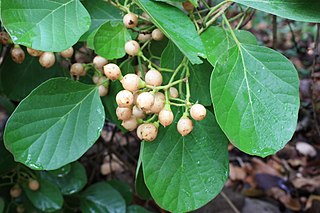
Cordia myxa, the Assyrian plum, is a mid-sized, deciduous tree in the borage family (Boraginaceae), native to Asia. It produces small, edible fruit and is found in warmer areas across Africa and Asia. Other common names in various languages include lasura, leswa,laveda, pidar, panugeri, naruvilli, geduri, spistan, burgund dulu wanan '"Iriki Chettu (Telugu) and ntege.

Cytisus multiflorus is a species of legume known by the common names white broom, white spanishbroom and Portuguese broom.

Panicum effusum, commonly known as hairy panic, is a grass native to inland Australia. It occurs in every mainland state, as well as New Guinea. In dry conditions, the fast-growing grass can become a tumbleweed.
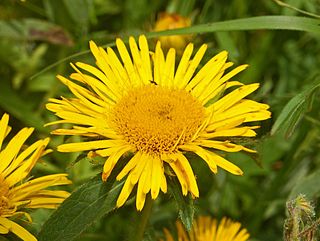
Pentanema hirtum is a species of perennial herbaceous plant belonging to the family Asteraceae. The specific Latin name hirtum refers to the type of hairiness of the plant.

Lotus hirsutus, also known by the synonym Dorycnium hirsutum, common name: canary clover or hairy canary-clover, is a species of flowering plant in the legume family Fabaceae.

Aegonychon purpurocaeruleum, commonly known as the purple gromwell, is a herbaceous perennial rhizomatous flowering plant and it belongs to the family Boraginaceae.

Betula alnoides is a species of birch that can be found in natural condition of such countries as Bangladesh, Bhutan, Cambodia, China, India, Laos, Myanmar, Nepal, Thailand and Vietnam at an elevation of 300–2,100 metres (980–6,890 ft) and higher in some cases. It is the southernmost of all known birch species, whose natural range reaches approximately 12° N in Cardamom Mountains, Cambodia.
Calothamnus accedens, commonly known as Piawaning clawflower, is a plant in the myrtle family, Myrtaceae and is endemic to the south-west of Western Australia. It was first formally described in 1984, declared extinct in 1992, rediscovered in 2004, removed from the "extinct" list in 2013 and found to have a population of at least 25,000 in 2015. It is a small erect shrub with crowded hairy leaves and red flowers. In 2014 Craven, Edwards and Cowley proposed that the species be renamed Melaleuca accedens.

Calothamnus hirsutus is a plant in the myrtle family, Myrtaceae and is endemic to the south-west of Western Australia. It is a small, spreading shrub with prominent hairs on the leaves giving them a smoky appearance. The flowers are deep red and are usually in dense clusters between the older leaves.

Cephalaria alpina, commonly known as the yellow cephalaria, alpine scabious or yellow scabious, is a species of flowering plant in the family Caprifoliaceae native to the Alps in Europe.

Eucalyptus capillosa, commonly known as wheatbelt wandoo, or mallee wandoo, is a species of tree or mallee that is endemic to Western Australia. It has smooth, grey bark, lance-shaped to elliptic adult leaves, spindle-shaped flower buds in groups of nine to thirteen, white flowers and barrel-shaped to cylindrical fruit.

Salix cavaleriei is a large tree from the genus of willow (Salix) with a gray-brown, furrowed bark. The leaf blades have lengths of 4 to 11 centimetres. The natural range of the species is in China. It is planted for logging and for fastening embankments.






















